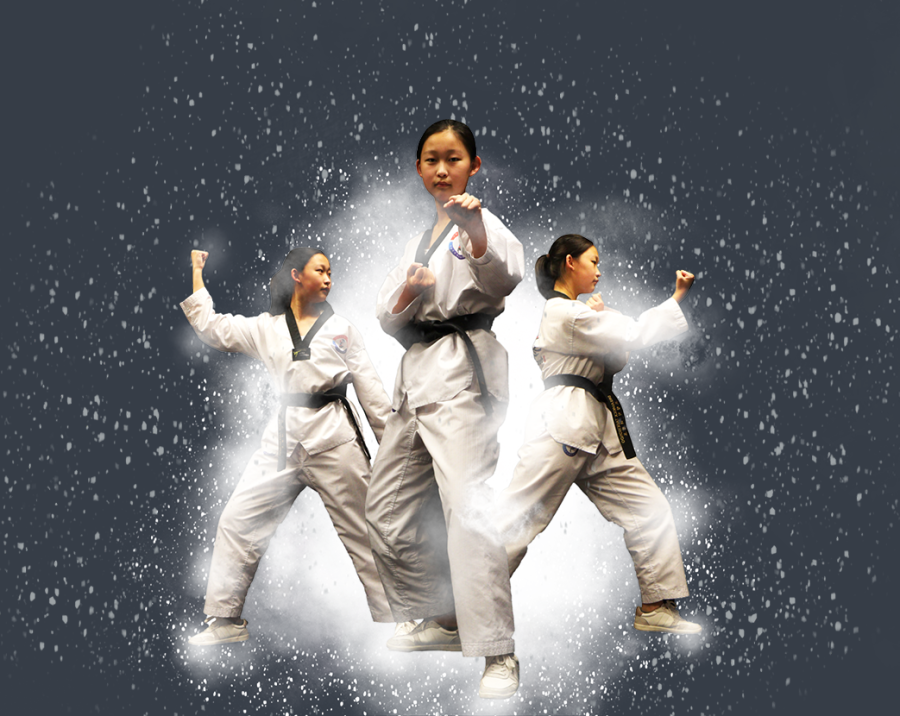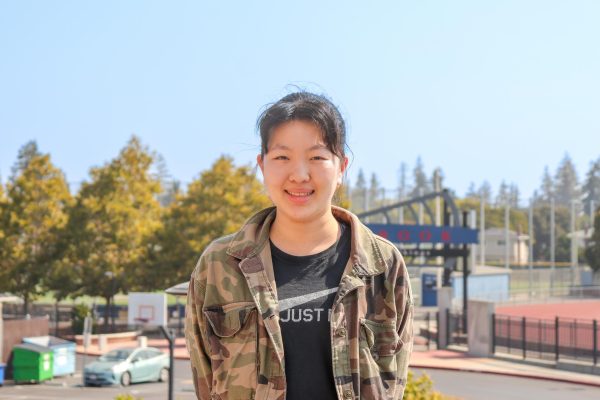Junior Hongyu Guo perfects her craft in taekwondo
Photos by Nicole Ge Graphic illustration by Vidushi Upadhyay
Junior Hongyu Guo competes in a form of taekwondo called poomsae, which is a performance of pre-established patterns or forms that places emphasis on accuracy and precision, with dozens of instructions for each move to ensure the move is correct and as accurate as possible.
April 10, 2023
Junior Hongyu Guo stands at the edge of the mat, wearing a taekwondo uniform adorned with a black belt, eyes focused and ready to perform. After bowing, she begins her poomsae routine, throwing accurate punches and powerful kicks in a show of athleticism, and cheers erupt as her routine comes to a close.
Guo discovered taekwondo in the summer of 2020, hoping to try something new during the COVID-19 pandemic. She committed to the sport because she enjoyed the challenge from its difficulty and complexity. Since then, she has joined the competition team and has become an instructor for children at her dojang, the name for a formal Korean martial arts training hall.
“I remember I struggled with learning very basic movements when I was first starting out and it frustrated me to no end,” Guo said. “I spent hours at home practicing movements to get them right because of how precise everything had to be. It was from that moment on that I started to take taekwondo more seriously.”
Taekwondo is a Korean form of martial arts that is known for involving powerful and precise high kicks. The two main branches of taekwondo are World Taekwondo and International Taekwondo Federation; Guo trains in WT, which is a more common style used for competitions while ITF is more traditional with a focus on sparring.
Guo trains at Dreamkick Taekwondo, where her training regimen shifts according to upcoming competition schedules. She generally spends around 10 hours a week at her dojang — three hours instructing and the rest for team training. However, her training schedule becomes more intensive during the competition season, spending twice as many hours a week at the dojang.
WT consists of a variety of forms, including sparring, demo and poomsae. Poomsae, the form which Guo competes in, is a performance of pre-established patterns or forms that places emphasis on accuracy and precision, with dozens of instructions for each move to ensure the move is correct and as accurate as possible.
“Poomsae is something that looks really simple to someone who isn’t well-versed in the aspects of it,” Guo said. “Although achieving mastery is practically impossible with scores above 8.3 out of 10 rarely given at international competitions, the beauty and intricacy of the art form makes the frustration from the difficulty worth it.”
Guo competes at least three times a year; she won two silver medals and one bronze team medal at the 2022 Amateur Athletic Union Nationals in Las Vegas, Nev. She found her experience at this competition especially memorable because she was able to bond with new people while waiting for her turn.
“I enjoy meeting new people while waiting to compete,” Guo said. “In Las Vegas, our team was signed up for three separate events, so we were stuck in the arena for around thirteen hours—four hours later than the expected release time—with little food and water. It’s safe to say that most of the people in my division became friends after that.”
While poomsae is a non-combative sport, injuries are a common occurrence. Guo has suffered a hamstring injury in the past that continues to affect her ability to perform at full capacity both in training and in competition. Although she knows it may cost her from earning the awards she wants, she understands that it is important to give her leg rest and be patient on her road to recovery.
“I’ve learned to let my leg rest as much as I can, even if it will cost me an award,” Guo said. “It’s difficult to balance injuries and competition, and it is definitely an uphill battle, but I’m giving it my all.”
Through experience, Guo has learned to accept her losses and grow from them. She believes that trying one’s best is enough and that success and validation should not depend on the medal one receives in the end.
“Bad things can happen, and that’s okay,” Guo said. “I learned that as long as I genuinely try my best and believe that the time I put in is reflected in my performance, awards don’t really matter.”
Taekwondo has helped Guo build confidence in herself, since her performance in poomsae is graded more on presentation than technique. In fact, the presentation category makes up 6 of the 10 points available, and there are many instances where the confidence from a player is the deciding factor between silver or gold. This has encouraged her to become more confident in the sport and in real life.
She hopes to continue to do taekwondo in college, although not at the same intensity and pace as she does now.
“People should learn taekwondo because there is such a wide variety of divisions of WT that everyone is bound to find something that interests them,” Guo said. “It’s a great form of exercise and can be enjoyed by people of all ages. And, let’s be honest, it looks really cool — especially demo.”




























































